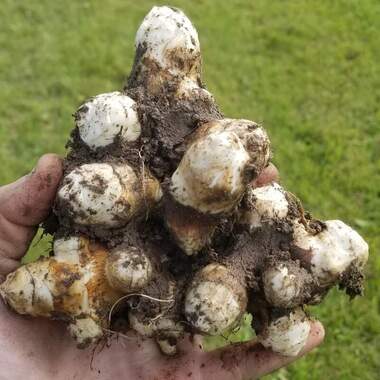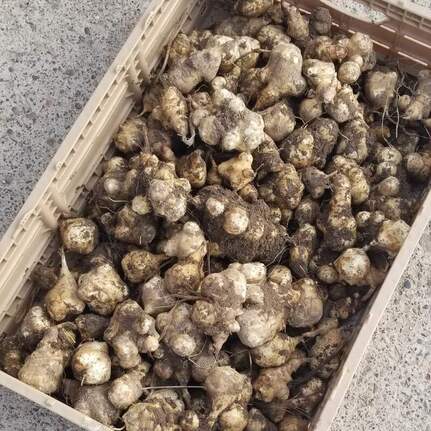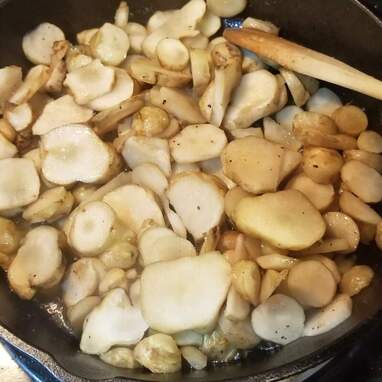Jerusalem ArtichokesIntroductionJerusalem artichokes (Helianthus tuberosus) are related to sunflowers (Helianthus annuus) giving them their alternative name, sunchoke. They produce tubers that can be dug up and eaten. Jerusalem artichokes are neither from Jerusalem nor are they closely related to artichokes (both are part of the Asteraceae family but do not share a genus). Instead, sunchokes are a native North American plant that the Native Americans ate. Jerusalem artichokes are very easy to grow, plant the tubers one time and they will grow as a perennial year after year. Many people claim Jerusalem artichokes are invasive, which is not accurate since they are native, although they can become invasive in regions where they were not originally native. Jerusalem artichokes, however, can be very aggressive. Therefore, do not plant sunchokes where you do not want them to spread or expect to devote a significant amount of time to digging up tubers to keep the plants contained. I planted my Jerusalem artichokes outside my garden with plenty of space to mow around them. We have had them for approximately 6 years and while they have spread slightly, they have mostly remained contained to one area. The tubers of Jerusalem artichokes grow underground and can be eaten raw or cooked. Before eating large amounts of sunchokes for the first time, you should be aware that they store their carbohydrates as inulin. Inulin is considered a prebiotic because is not digested in the intestines but instead feeds beneficial bacteria. This is thought to help maintain digestive health and may be beneficial for diabetics as the inulin is not broken down to sugar like many other starches. However, the major side effect of inulin is the production of gas by bacteria in the gut as they break down the starch. Therefore, a common, and well-deserved nickname for Jerusalem artichokes is “fartichokes” and only small amounts should be ingested first to see how your body reacts. Overconsumption can lead to painful bloating, gas, and diarrhea. Other foods that contain large amounts of inulin include onions, artichokes, asparagus, and chicory. However, these foods are rarely consumed in quantities large enough to cause gastric distress. How to Grow Jerusalem ArtichokesYou can buy Jerusalem Artichoke tubers from many seed suppliers, I purchased them from Jung Seed but Fedco Bulbs also sells them. They can be planted in most soil types, but if your soil is especially poor amend with compost or composted manure first. You can plant the tubers in early spring as soon as the soil can be worked or in warmer climates they can be planted in the fall. They are very cold hardy, and grow well for me in central Wisconsin, zone 4b, but will grow from zones 3-9. Plant the tubers about 6 inches deep, roughly 12 inches to 2 feet apart. We planted six tubers and eventually ended up with a patch roughly 4x6 feet which is more than enough for our small family of three. The plants grow very tall, 10-12 feet high, so do not plant them where they will shade other plants that need full sun. I try to keep my bed mulched to reduce weeds but since sunchokes are vigorous plants they grow well even with high weed pressure. To increase tuber size, you can cut off the tops of the plants when they begin to flower. In my zone, we only sometimes see full flowering since sunchokes flower late in the season. If you do let them flower, however, they are beautiful sunflower-like flowers. The flowers are smaller than most sunflowers and multi-stemmed. Harvesting Jerusalem ArtichokesUsually, Jerusalem artichokes are harvested in late fall after frost and the foliage has died back. You can dig them up sooner, but the cold is supposed to improve the flavor of the tubers. We usually dig the tubers with a shovel, but you can also use a garden fork to loosen the soil and pull out the tubers by the stem. Harvesting all the tubers is almost impossible; any remaining behind will grow into next year's crop. Unfortunately, Jerusalem artichokes do not store well so it is recommended that you only pick as many as you can eat in a couple of weeks. I have also sliced, blanched, and frozen or dehydrated them to use later. I have also tried fermenting them (you can find recipes online) but I had mold grow the first time and was not a huge fan of their taste the second time when they fermented successfully. How to Eat Jerusalem ArtichokesJerusalem artichokes are knobby and should be peeled or scrubbed well to remove the dirt. They can be eaten raw, for example, sliced onto a salad, but my preferred method of eating them is cooked. I like to slice and boil them slightly to soften them and then sauté them in cast iron with shallot or onion. I find Jerusalem artichokes to have a strong flavor, somewhat nutty, and unique. For our family, sunchokes are a good supplement to our food supply, especially since after planting, they are very low maintenance. ReferencesCox, Jeff. 1988. How to Grow Vegetables Organically. Rodale’s Organic Gardening Magazine, Rodale Press, Emmaus, Pennsylvania.
0 Comments
|
Details
AuthorIn 2016, my family and I moved from the New York City area to small town Wisconsin. Our move, this website and blog (and our previous Etsy store) is the result of our desire over the past several years to simplify our lives, increase our quality of life, reconnect with nature, and enjoy a more self-sufficient life. I grew up as a country kid in central Pennsylvania working on my grandfather's fruit farm and as a corn "de-tassler" at a local seed farm. My background is in biology where my love of nature originated. I am a former research scientist and professor and have now transitioned to a part-time stay-at-home mom, self-employed tutor, and small business owner. Thank you for taking the time to check out my site. Archives
July 2024
Categories
All
|




 RSS Feed
RSS Feed